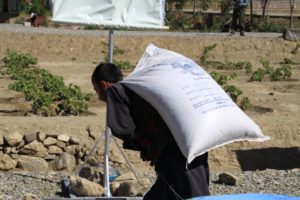Hunger driving migration – UN report
Hunger is a key driver of human migration and dislocation and coupled with armed conflict has led to the largest refugee crisis in modern history, a new study has found.
As the world grapples with four separate potential famines for the first time in decades, the report by the UN’s World Food Programme found that the more people go hungry at home the more likely they are to migrate.
The study, the first report to comprehensively analyse the link between hunger and migration, found that the number of people fleeing a country increases by 1.9 per cent for each percentage increase of food insecurity.
Prolonged conflict also pushes more people to abandon their homes, with refugee outflows increasing 0.4 per cent for each additional year of war, the study said.
And food insecurity was a cause of the incidence and intensity of conflict.
“Food insecurity was also found to be a critical ‘push’ factor driving international migration along with income inequality, population growth and the existence of established networks for migration,” said the report, titled ‘At The Root Of Exodus: Food security, conflict and international migration’.
 The report said the act of migration itself can cause food insecurity because of migrants’ lack of income opportunities, adverse travel conditions along the journey and the high costs of transit.
The report said the act of migration itself can cause food insecurity because of migrants’ lack of income opportunities, adverse travel conditions along the journey and the high costs of transit.
“Once a migrant’s journey has begun, food and economic security are important factors in a migrant’s decision about whether to continue a journey or settle in the first relatively secure location,” it said.
The report said that half of Syrians living in Jordan and Lebanon said they would prefer to move to another country because of a lack of economic opportunity and low levels of assistance provided there.
It found that migrants who flee conflict typically are family groups while migrants who depart for economic reasons are typically single and usually male.
“Importantly, the study found that migrants have access to social media and mobile technology and that the use of such technology has revolutionised information flows,” the report said.
“Access provides migrants with real-time, accurate information that empowers them to make better decisions about which route to pursue and other aspects of the journey,” it said.
“By understanding the dynamics that compel people to move, we can better address what lies at the heart of forced migration and what must be done to end their suffering,” the report said.
More than 20 million people risk dying from starvation because of drought and conflict in Yemen, Somalia, South Sudan and northeast Nigeria, while more than 100 million face acute malnutrition worldwide, according to the United Nations.
Famine was declared in some areas of South Sudan in February – the first official famine in six years.
The study, based on interviews with migrants from 10 countries, also found that people often joined armed groups to feed their families.
A record 65.3 million people are currently displaced, according to UN data.
Some 1.6 million refugees and migrants reached the European Union in 2014-2016 leading to disputes on how to share the burden among member states.
The study outlined a series of key recommendations as a response to rising levels of forced migration.
It said the fundamental request of refugee communities was international assistance in in ending hostilities.
It recommended adequate livelihood and social support including food assistance for people displaced internally in their own countries as well as for those forced to move to neighbouring countries.
It said support should also be provided to vulnerable individuals in host communities where large numbers of migrants have settled and that uniform policies and approached be adopted among all stakeholders in response to international migration.
It also recommended further research into the trends of international migration to further understanding of the interplay between food insecurity, conflict and the other factors that compel people to leave their homes.
Laurie Nowell
AMES Australia Senior Journalist












